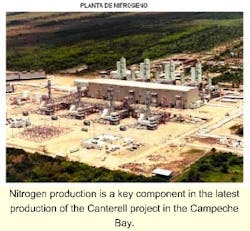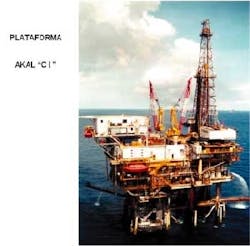Cantarell production output up 60% following injection startup
Oil production on Mexico's top-performing super-giant oilfield, known as Cantarell, is up by almost 60% from six years ago. Output capacity is expected to continue to increase, thanks to the recent start-up of nitrogen injection into the field to maintain pressure, says Antonio Acuna, executive director of the Petroleos Mexicanos (Pemex) Cantarell Project.
Work on most aspects of the Cantarell Project has been accelerating. Worthy of special mention is the nitrogen-injection infrastructure, which was fully operational in August, 2000, seven months ahead of the original estimated March, 2001 completion date.
A giant nitrogen-production plant, unique in the world, has been built on the Atasta peninsula, near the Campeche Bay offshore oil fields, to produce 1.2 Bcfd of nitrogen for injection into Cantarell. Each one of its four 300 MMcfd units would, on its own, be the single biggest nitrogen production plant in the world.
The US$1billion nitrogen plant was built by a six-nation consortium formed by BOC Gases, Marubeni, Linde, Westcoast Energy, and ICA-Fluor Daniel. The consortium has a $2.7 billion, 15-year contract to supply Pemex with nitrogen, which is being injected into Cantarell to maintain pressure and allow additional oil to be obtained in the long term. The long-term benefit expected from this secondary-recovery program will be to increase recoverable reserves on the field by 2.3 billion bbl of oil.
Adding infrastructure
Currently, Cantarell is producing 1,560,000 b/d of heavy Maya-type crude oil, up from an average of almost exactly 1,000,000 b/d in 1994, according to Acuna, who notes that the $10.5 billion Cantarell Project in Campeche Bay is now 80% complete, in terms of adding new infrastructure.
The Cantarell Project involved adding 26 platforms, 285 miles of pipelines, and 36 other major work projects related to interconnecting and operating the offshore platforms. Of the $10.5 billion in total outlays, 96% of which are to be made by year 2002, new infrastructure accounts for $7.2 billion, while the other $3.3 billion will go to maintenance and operational expenditures. Of the outlays on infrastructure, just over half has already been spent.
Paid for itself
The Cantarell Project, as of mid-year 2000, has already paid for itself, says Acuna. Total accumulated investments on the project, which began in 1997, stood at 4.32 billion dollars in July 2000. Pemex's estimate of accumulated income, due directly to work related to the Cantarell Project, amounted to 4.73 billion dollars as of July. The biggest benefits, however, are expected to come in future years, as income will far outpace future investments.
The project is highly profitable, especially at recent oil-price levels. The cost of producing a barrel of oil on Cantarell, in the first half of this year, was US$2.83, which compares to a $21.69 average price for a barrel of Maya crude in international markets over the same period.
Acuna exudes enthusiasm. "There is no parallel to this oil field, nor to this project, anywhere in the world. It is the biggest offshore oil field anywhere and has been producing 1 million b/d for 20 years. In any other oil field, we would be working to maintain production or to reduce the decline of the field after 20 years. But not here. We are still moving production up", he says of the project, which provides just over half of Mexico's total oil production and has been the mainstay of the country's increasing oil exports.
"The progress and achievements, two and a half years after beginning the project, have been substantial. The difficulties and challenges have been successfully overcome and none of the original goals of the project have been modified. Moreover, it has been a particularly tough job doing all of these modifications to an oil field, on which the 1 million b/d output had to be maintained ," he added.
He also assures that increased production levels on Cantarell, as a direct result of the project, are helping Mexico to sustain its total oil output at levels close to 3 million b/d, as the super-giant field is compensating for gradual declines in production on many of Mexico's other oil fields.
It should also lift the country's total crude oil output capacity to close to 3.3 million b/d within a couple of years. Some of Mexico's light crude fields, particularly offshore Abkatun, have suffered serious declines in recent years.
Aiming for 1.8 million
Due to the startup of pressure maintenance on the field, Cantarell now has capacity to produce 1,896,000 b/d of oil. Moreover, that capacity will jump to 2,230,000 b/d by year-end 2002, plus 878 Bcfd of associated natural gas, when all outlays considered in the Cantarell Project, in its current scope, will have been completed.
The building of such an expensive nitrogen-injection plant had been controversial, but this part of the project "is now a closed chapter. It was also the part that was most urgent to us," Acuna says. Some technical observers of the project are still concerned, however, about how nitrogen will act on the reservoir underground, but Acuna says sufficient tests of all kinds have now been made to ensure that injecting nitrogen is the best option for the field.
This additional capacity on Cantarell allows for greater flexibility in handling production and in responding to changes in demand in the global oil market. Overall, Pemex is now producing 1,740,000 b/d of heavy Maya crude (1,560,000 b/d from Cantarell and 180,000 b/d from the nearby offshore Ku-Zaap-Maloob group of fields). Total Mexican oil output for January-June stood at 3,011,000 b/d.
The Cantarell Project is complex in nature and amounts to a general upgrading of infrastructure and exploitation of the offshore field. Objectives include optimizing and automating the production systems, increasing oil reserves, modernizing facilities, reversing what had been a decline in oil output on the field and halting the drop in output rates on wells. Cantarell would be producing only about 800,000 b/d currently, if the Cantarell Project had not been conceived and implemented, according to Pemex's calculations.
Gas compression
Another aspect of the project making headway is the addition of offshore gas compression capacity, which in turn, helps Pemex reduce the amount of gas being flared. Two offshore compression units are going into operation this year, meaning that about 500 MMcfd of gas can be sent to processing, instead of being flared. Another major unit will come on line in year 2001. Pemex expects to reduce offshore gas flaring to a minimum by the end of year 2000, according to Acuna.
The Cantarell Project was conceived in 1995, at a time of much higher expectations for growth in demand for crude oil. Additional oil-export income also seemed a priority for Mexico to get over a temporary financial crisis at that time. Since then, global oil output restrictions, in which Mexico participates along with OPEC countries, has meant that all the new capacity being added on Cantarell may not be used soon.


